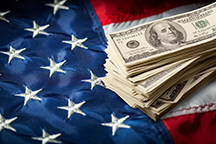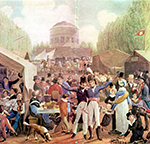 America’s Boom and Bust in the 1800s By Lawrence R. Anderson, Jr. – Attorney at Law
America’s Boom and Bust in the 1800s By Lawrence R. Anderson, Jr. – Attorney at Law
In preparing to write the second installment for my series on how Americans have historically dealt with financial crises, two respected news sources, the Wall Street Journal and Reuters News Service had seemingly contradictory headlines. The morning of July 7, Reuters’ Lucia Mutikani reported U.S. labor market starts to cool as weekly jobless claims rise, layoffs surge (10:58 AM CDT).1 In the early afternoon of July 8, Mutikani reported U.S. labor market powers ahead with strong job gains despite recession fears (July 8, 2022).2
Later that same day, the Wall Street Journal’s Sarah Chaney Cambon reported that the U.S. Added 372,000 Jobs in June, subtitling her article, Despite strength in labor market, broader economy has been weakening in response to high inflation and rising interest rates.3 While both the job and the stock markets are important predictors for the financial future of our country, tracking trends in consumer spending may have more practical, immediate impact for the average American family and business.
In WSJ’s pre-July 4 holiday edition, Cambon and Rina Torchinsky detailed how consumers are coping with current economic conditions in their article, Americans Have Had It With Inflation: Consumers are cutting back on spending as they contend with historically high inflation.4 “Consumers’ short-term outlook on the U.S. economy reached the lowest point in nearly a decade, the Conference Board’s latest consumer-confidence survey showed. A separate survey of consumer sentiment fell to its lowest point on record… Cutbacks in consumer spending threaten to weigh on U.S. economic growth, which is flashing signs of slowdown. Many forecasters are increasingly fearful that the economy could fall into a recession under the weight of rising inflation and the Federal Reserve’s attempts to curb it through aggressive interest-rate hikes.”5
Specialty foods at grocery stores, dinner and drinks in trendy restaurants, new clothing, and luxury cars which burn lots of gas are being passed over in favor of more economical alternatives. Or, if an expense is not necessary, a purchase is not made at all.
In my first article published July 4, How Our Founding Fathers Avoided National Bankruptcy, I wrote about the courage President George Washington and Treasury Secretary Alexander Hamilton displayed and the strong measures they took to save our country from economic disaster. I also included down-to-earth advice on how present-day consumers can prepare their family and business finances for these uncertain times. My second article focuses on the crushing struggles many Americans faced during multiple “boom and bust” economic cycles which plagued our nation’s rapid westward expansion.

The “boom” began with President Thomas Jefferson’s purchase of the Louisiana Territory from France in 1803. The Purchase nearly doubled the size of our country, providing growth opportunities for humble settlers and adventuresome entrepreneurs alike. On January 8, 1815, the Americans’ stunning defeat of the vastly superior British army at the Battle of New Orleans ushered in the “Era of Good Feelings.”
The American victory astounded people around the world and firmly established our national feeling and character. It also made General Andrew Jackson into a national hero, eventually winning him our country’s Presidency in 1829. The United States was “effectively…unified for the next 45 years until the American Civil War.”6

Louisianans may be interested to know that the “Eighth of January was a federal holiday from 1828 to 1861 and it was equally as important and celebrated as the Fourth of July. The anniversary of the battle was celebrated as an American holiday for many years called ‘The Eighth’.”7
Nevertheless, there was a downside to Jackson’s popularity that had mixed results. “The Democratic-Republican Party used the victory to ridicule the Federalist Party as cowards, defeatists, and secessionists. In fact, the Federalist Party ceased to exist after the Battle of New Orleans…From 1815 to 1825 there was single-party rule in Washington and an overwhelming feeling of patriotism due to the extinction of the Federalist Party.”8
According to American historian, Andrew Browning, the bust began at the same time as the boom, “in 1815 as a regional depression in eastern commercial cities and mill towns, spreading down the Ohio River in 1816 and 1817; it evolved into a banking crisis in 1818 and became a full-blown national depression with the collapse of cotton prices in 1819 and a tide of business failures and bankruptcies that left no region unscathed. The sudden end of the western land boom left millions of dollars in unpaid debts, and hard times lingered in the South and West well into the mid-1820s.”9
Browning’s fascinating book, The Panic of 1819, closely examines America’s “first great depression,” adding it was “of all the critical events in American history perhaps the least known and least appreciated…It is no exaggeration to say that the Panic of 1819 changed the country profoundly, in ways that go well beyond the world of finance.”10
Few legal remedies were available at this time not only for creditors but also and especially for debtors. “The Supreme Court struck down New York’s bankruptcy statute as unconstitutional, but Congress refused to pass a national bankruptcy law, which the Constitution explicitly empowered it to do.”11
Browning paints a grim picture of the unfortunate circumstances experienced by many once hopeful people with Dickensian clarity. “Laid-off agricultural workers in the countryside tried to camp in the woods and live off the land; the middle class in the cities lost their income and wound up in debtors’ prisons. Those least responsible for their own distress were the most frequently held accountable for it: the unemployed poor.”12

The Panic of 1819 “introduced the American people to the pattern of boom and bust that has since become known as the business cycle; it was first of the series of financial crashes and economic depressions (called “panics” in the nineteenth century) that have since recurred at regular intervals.”13 Subsequent “panics” occurred in 1837, 1857, 1873, and 1893.
While Bankruptcy Acts were enacted in 1841 and 1867, the Act of 1898 was “a watershed in American bankruptcy law’,” including “more generous discharge provisions for the debtor than under prior bankruptcy law, but permitted a debtor to claim exemptions only under State law, and provided for both voluntary and involuntary bankruptcy cases.”14 Thus the 1898 Act was the turning point in providing debt relief to both creditors and debtors.
No debtor wants to file for bankruptcy, even as a last resort. However, as an attorney I am grateful we live in a country, whose legal system allows second chances and clean starts for those in need. And I am proud to provide hope and encouragement to anyone struggling with financial problems. As I did in my first article, I am ending this post with suggestions taken from the same excellent online article by Equifax. This section focuses on prioritizing debt repayment.
Prepare for the … Recession
(Accessed July 8, 2022) in Equifax. https://bit.ly/3yEeQE9
Excerpt, Way #2: Prioritize Debt Repayment
You might be worried about paying off outstanding debts in the coming months, like credit card bills, utilities or student loans. If you experience a loss of income, you might have to forego paying one or more of these bills, so it’s important to understand which bills you need to pay.
After all, if you lose income, you may not be able to pay every bill on time or in full every month. And, that will have a direct impact on your credit scores. While normally we suggest doing whatever you can to keep your credit scores intact, that may not always be possible. Therefore, you should prioritize how you pay your bills, so your available cash covers as many debts as possible.
Make sure you pay your rent or mortgage on time and in full. You don’t want to face foreclosure or eviction.
- Make your car payment, especially if you need a car to get to work.
If you’re facing an income reduction, contact your student debt lender and ask for a hardship application, which may buy you a few months where you don’t have to make a payment.
Make at least your minimum payment on your credit card. If that’s not possible, contact your credit card company and try to work out a payment plan. (Just know that the creditor will likely freeze your accounts, which will prohibit you from making additional purchases with the card.)
Continue to keep up with your medical debts if you can, however, do so after other debts are met first. If your health insurance is offered through your employer, you will continue to receive health insurance coverage even if your medical bills mount. If you buy your own health insurance, whether you’re self employed or for any other reason, be sure you pay your premium on time so your policy isn’t canceled.
Remember, if you’re falling behind, reach out to your creditors right away and ask for hardship concessions. This might include making interest-only payments on your debt or putting payments into forbearance.
You can also check out your local bank or credit union for a personal loan. There are online lenders as well, and your own employer may offer a short-term loan program in times of trouble.
If you’re making your payments on time, you can also ask your credit card company or any other lender about lowering your interest rates. A significant number of major utility providers offer programs that might allow you to pay your bills at a later date or provide other hardship assistance. You’ll never know what agreement you and your creditor can reach if you don’t ask.15
Next Monday, July 18, I will conclude my personal finance preparation series with a post on American economics beginning with the Great Depression of 1930 up through our present time. The practical advice segment will include Experian’s tips on community and government aid programs (with Louisiana-based links), building an emergency fund, and suggested resources to keep you abreast of financial solutions.

I wish you and your family continued success on safeguarding your family and business finances.
###
If you would like more information about how I can help you protect your family or business assets, please download my business card, call (225) 324-7459 or email [email protected].
1 U.S. labor market starts to cool as weekly jobless claims rise, layoffs surge By Lucia Mutikani July 7, 2022 10:58 AM CDT https://www.reuters.com/markets/us/us-weekly-jobless-claims-rise-layoffs-hit-16-month-high-june-2022-07-07/
2 U.S. labor market powers ahead with strong job gains despite recession fears By Lucia Mutikani July 8, 20221:10 PM CDT https://www.reuters.com/markets/us/us-job-growth-beats-expectations-unemployment-rate-holds-36-2022-07-08/
3 U.S. Added 372,000 Jobs in June: Despite strength in labor market, broader economy has been weakening in response to high inflation and rising interest rates By Sarah Chaney Cambon Updated July 8, 2022 4:33 pm ET https://www.wsj.com/articles/june-jobs-report-unemployment-rate-economy-growth-2022-11657237512
4 Americans Have Had It With Inflation: Consumers are cutting back on spending as they contend with historically high inflation By Rina Torchinsky and Sarah Chaney Cambon July 3, 2022 5:30 am ET https://www.wsj.com/articles/americans-have-had-it-with-inflation-11656840601?mod=Searchresults_pos2&page=1
5 Ibid.
6 Battle of New Orleans. (Accessed July 10, 2022) in Wikipedia. https://en.wikipedia.org/wiki/Battle_of_New_Orleans
7 Ibid.
8 Ibid.
9 Browning, Andrew H. The Panic of 1819 (Studies in Constitutional Democracy) (p. 4). University of Missouri Press. Kindle Edition.
10 Ibid. (p. 3).
11 Ibid. (p. 7).
12 Ibid. (p. 8).
13 Ibid. (p. 3).
14 A Relatively Short History of the Bankruptcy Laws in the United States. Posted by Robert Jacobvitz – on February 27, 2019. (Accessed July 10, 2022). https://ncbjmeeting.org/2019blog/2019/02/27/a-relatively-short-history-of-the-bankruptcy-laws-in-the-united-states/
15 5 Ways to Prepare for the Covid-19 Recession (Accessed June 30, 2022) in Equifax. https://bit.ly/3yEeQE9
